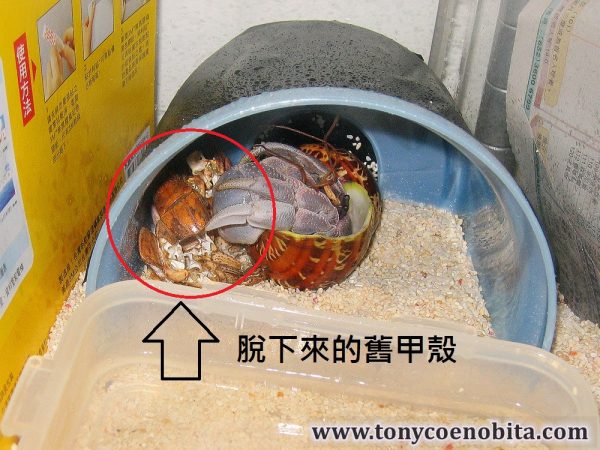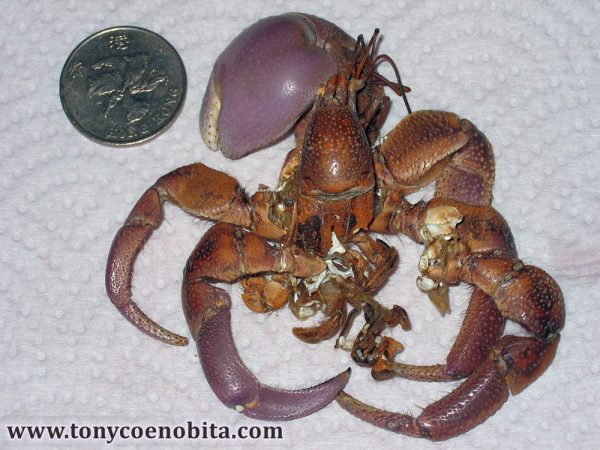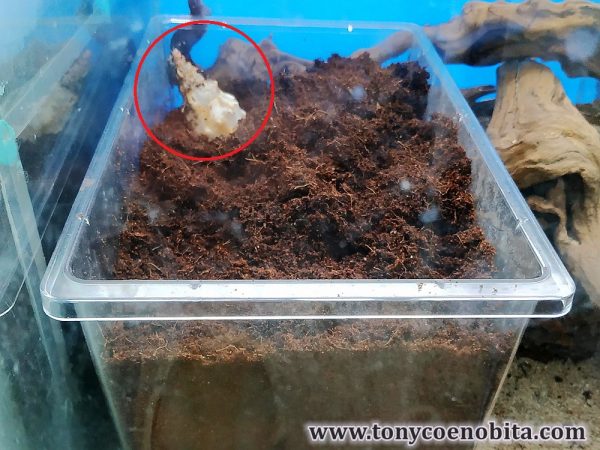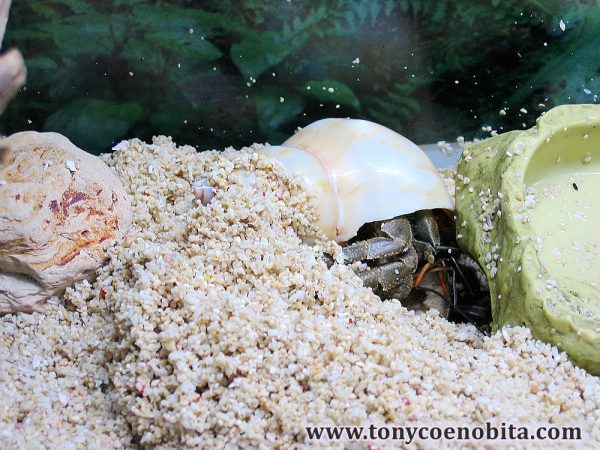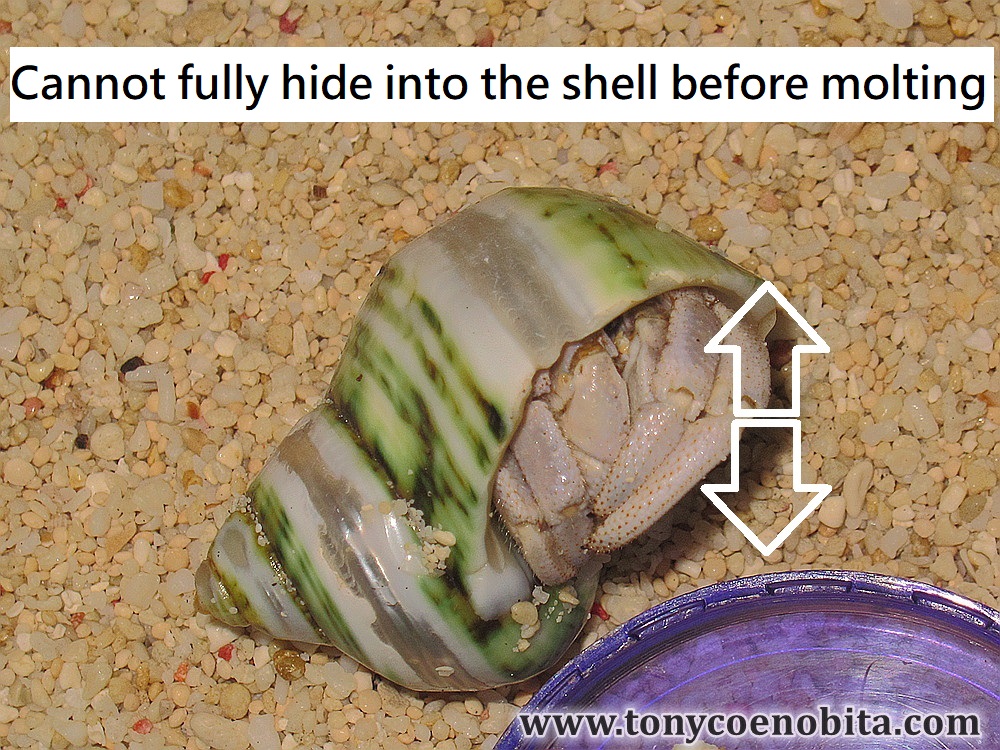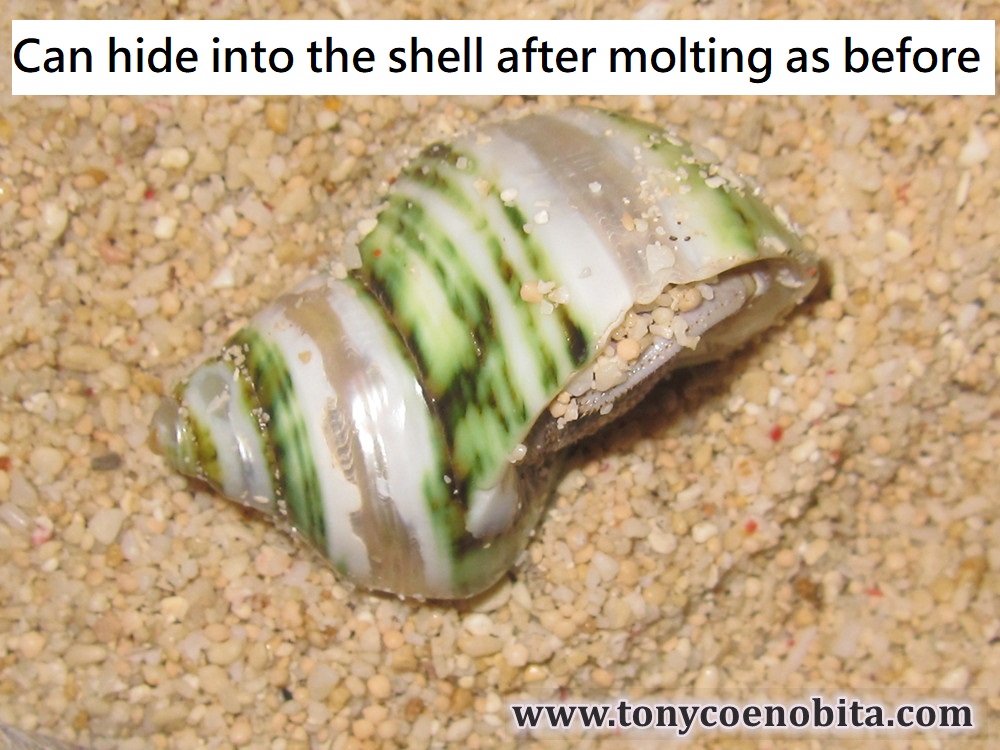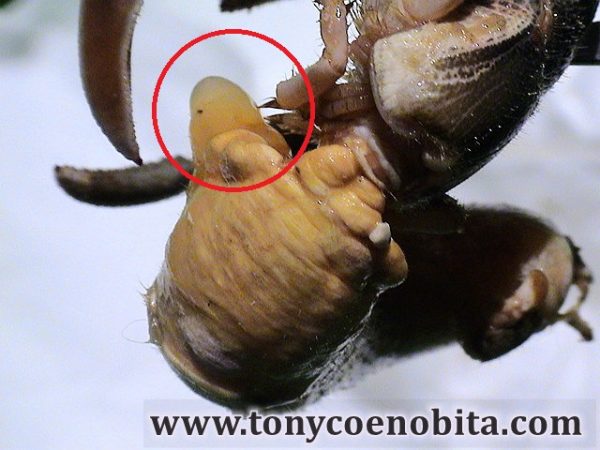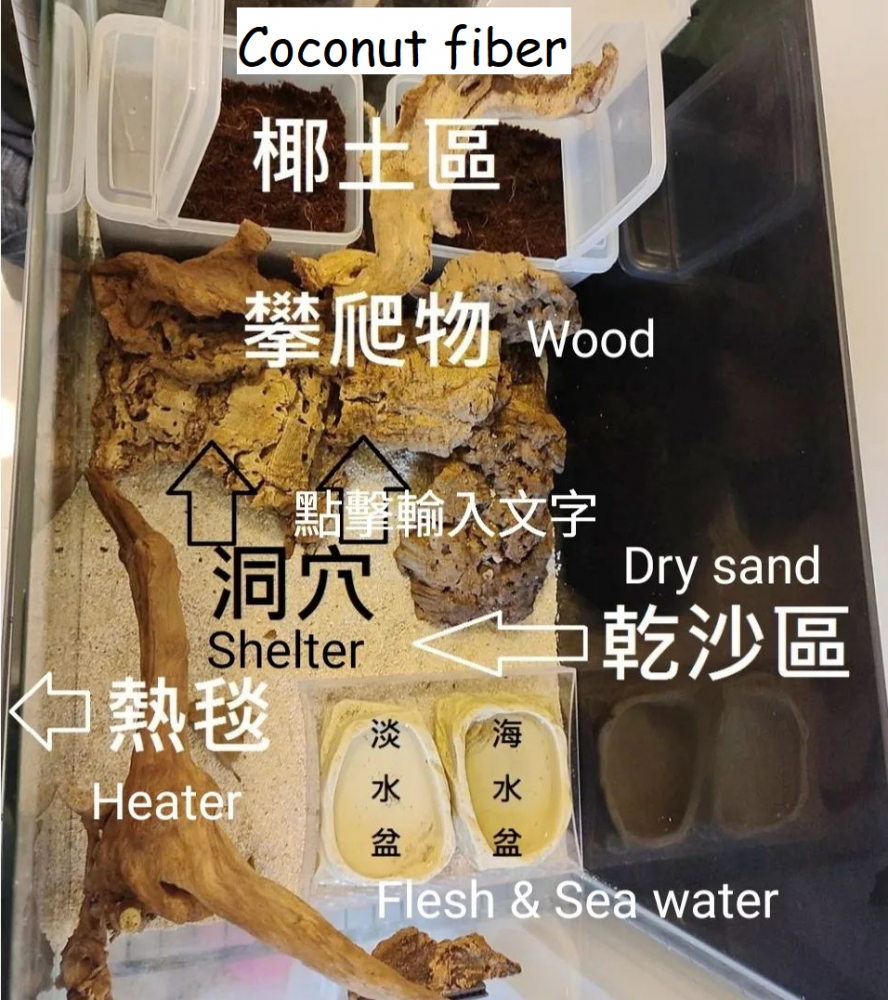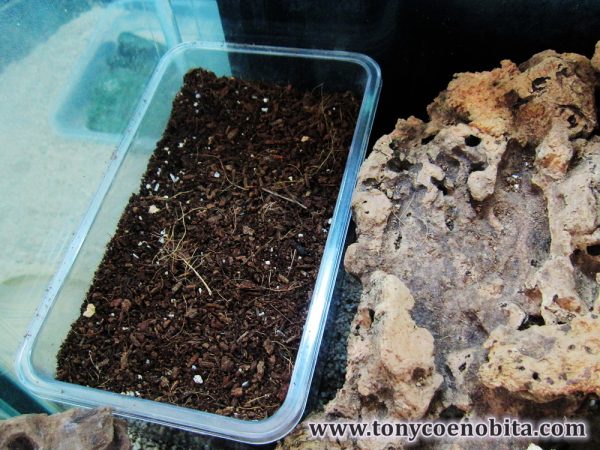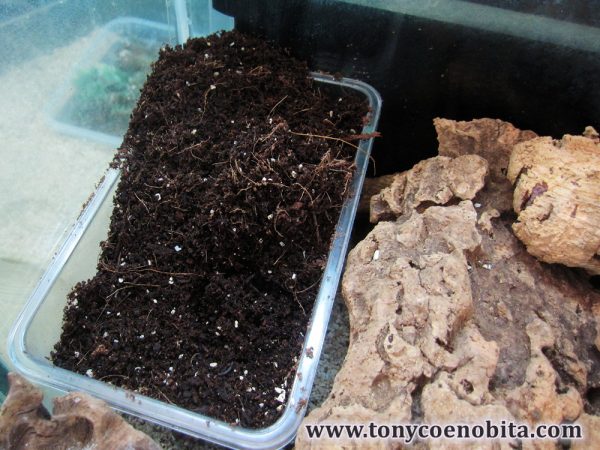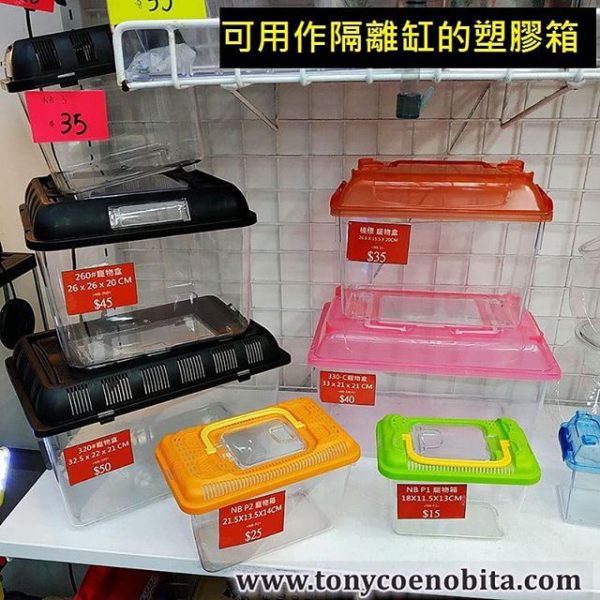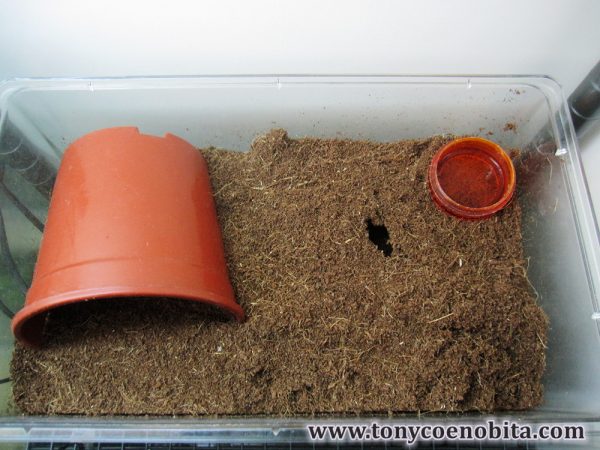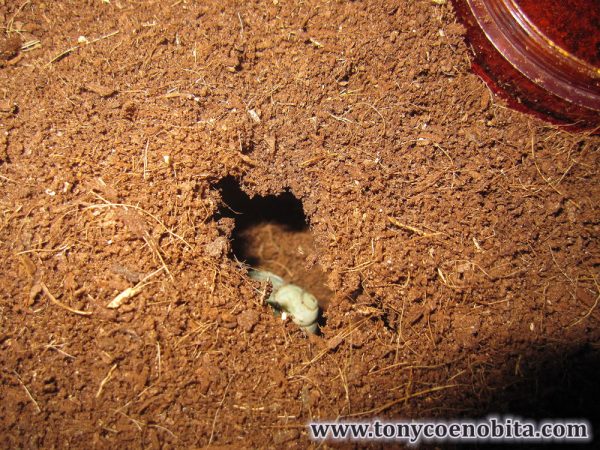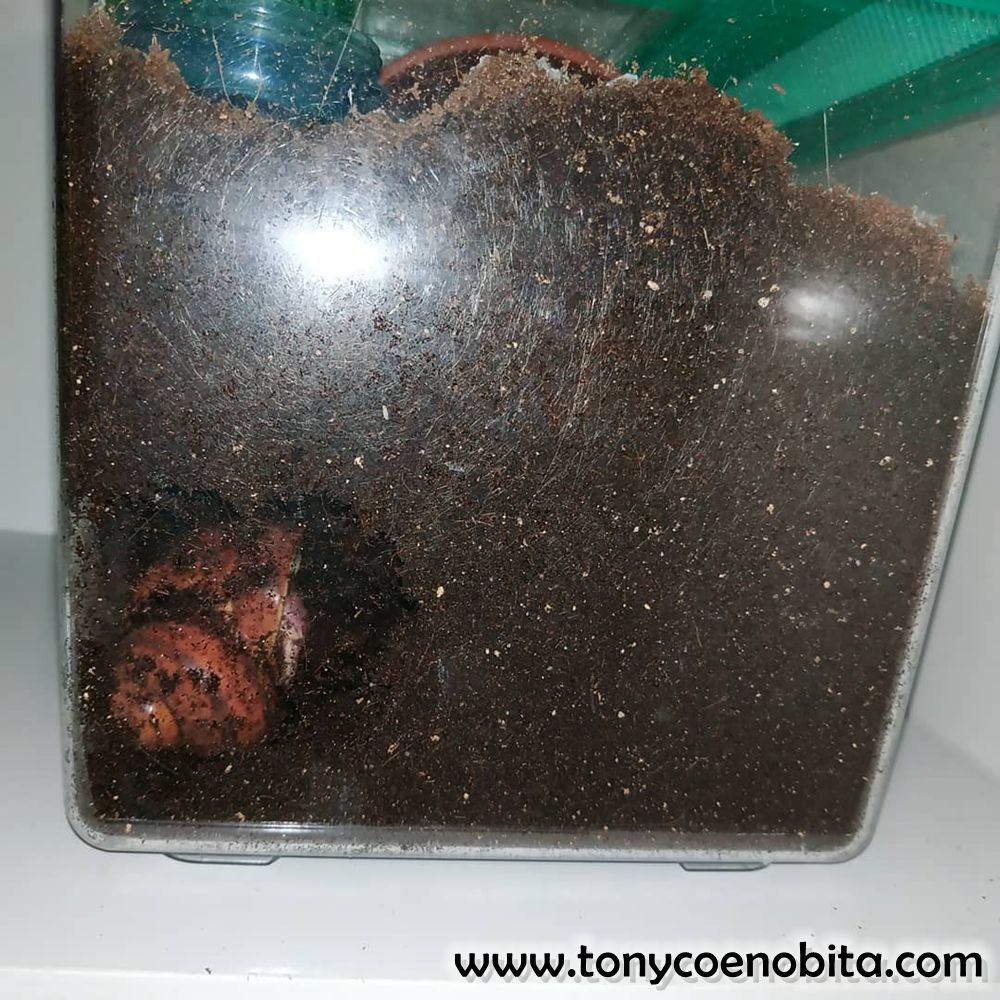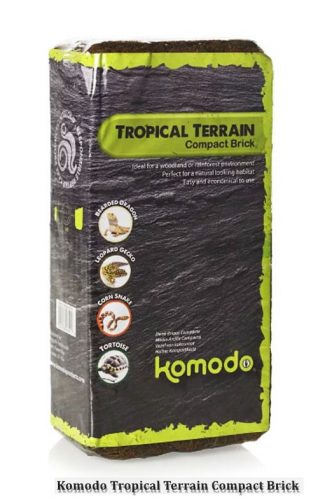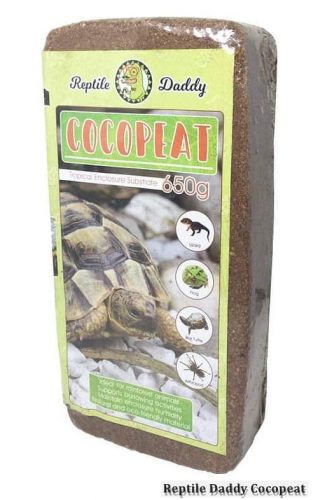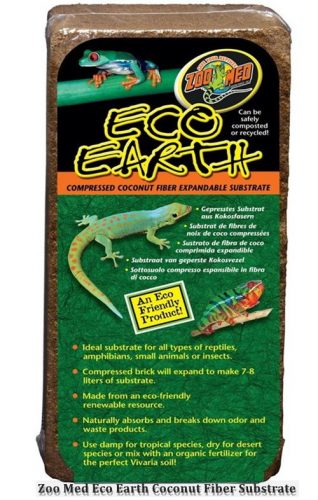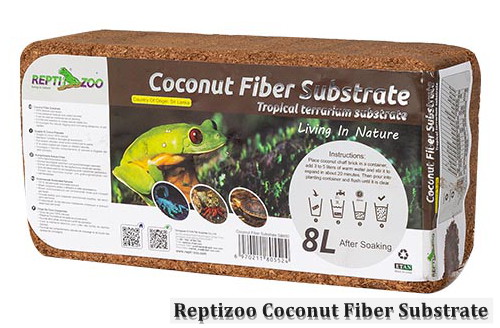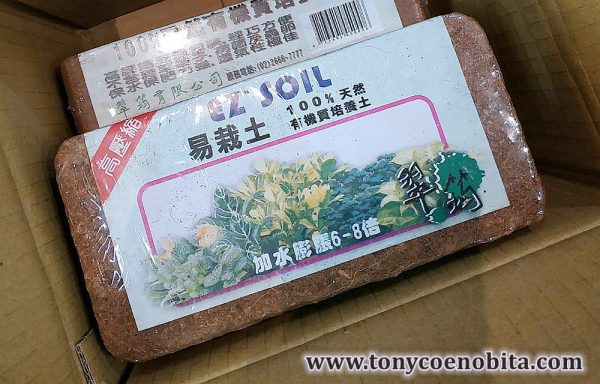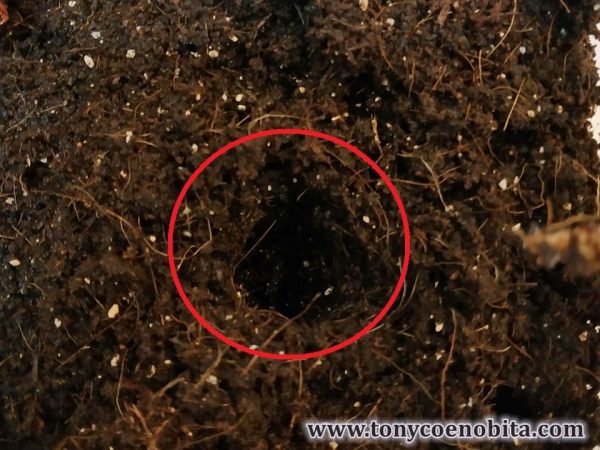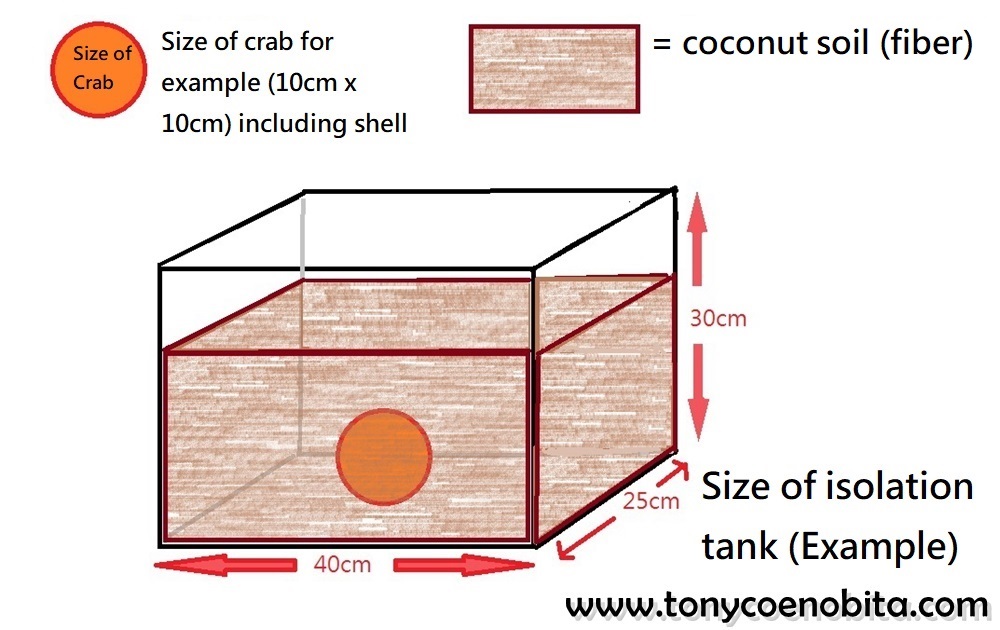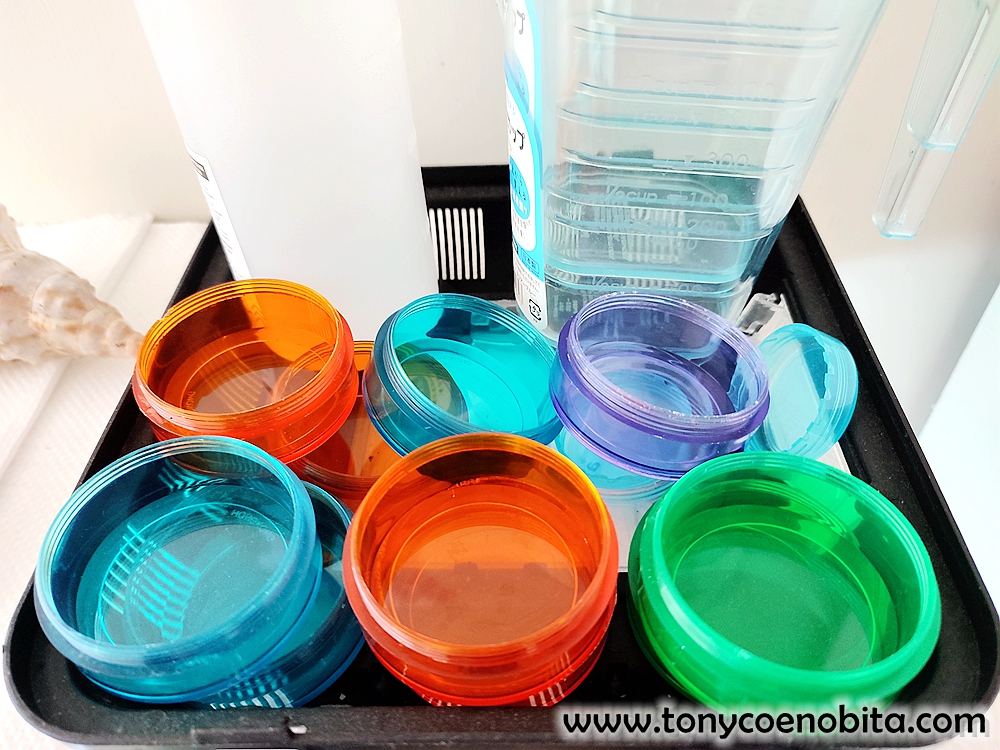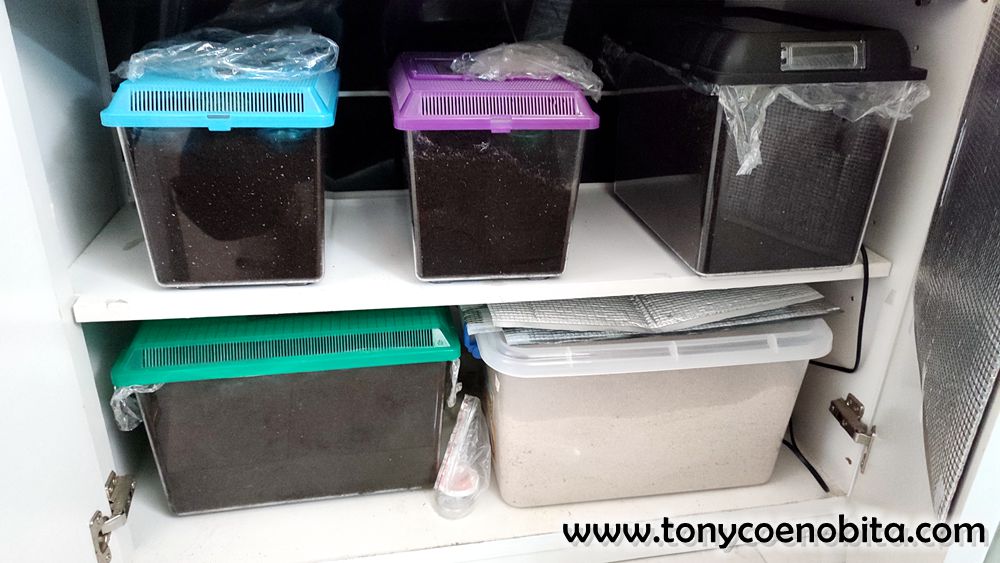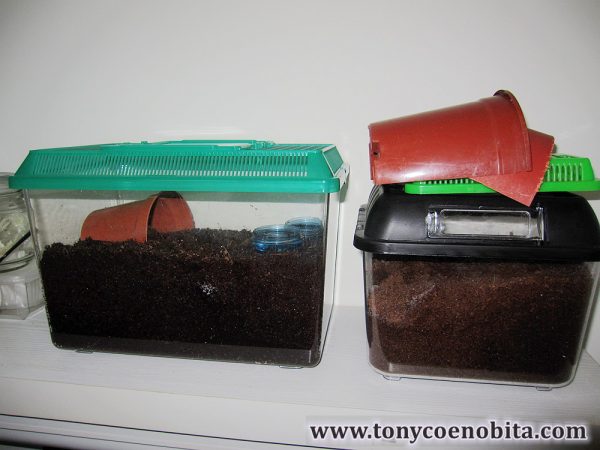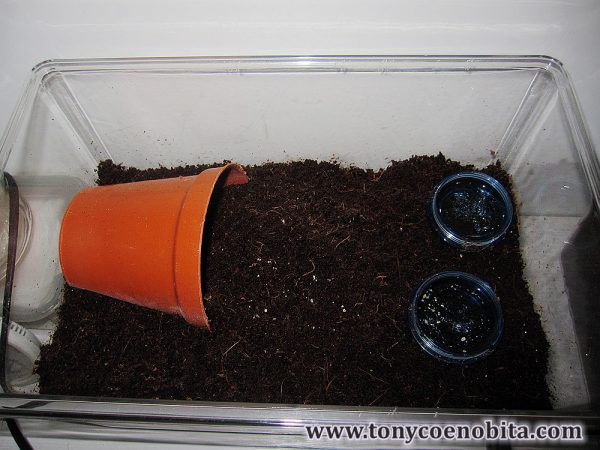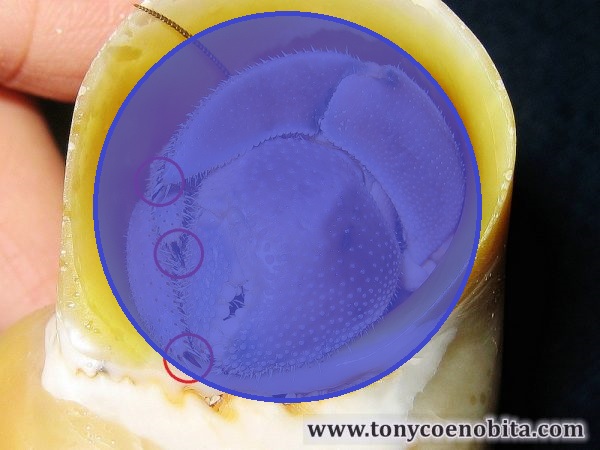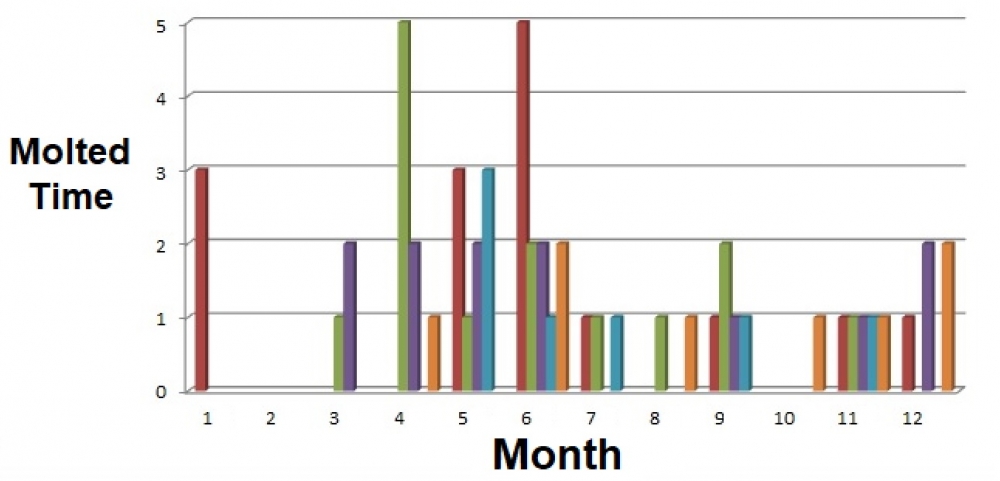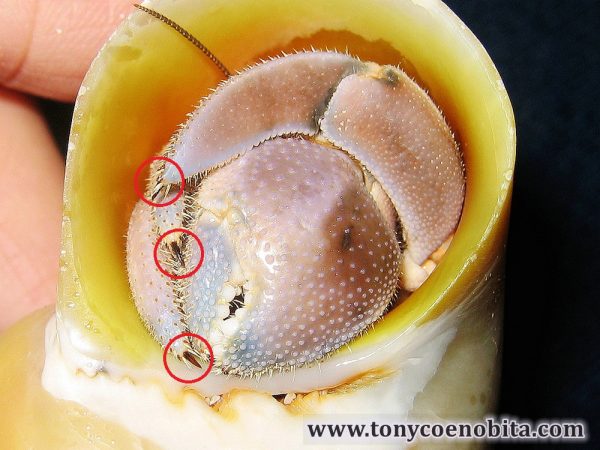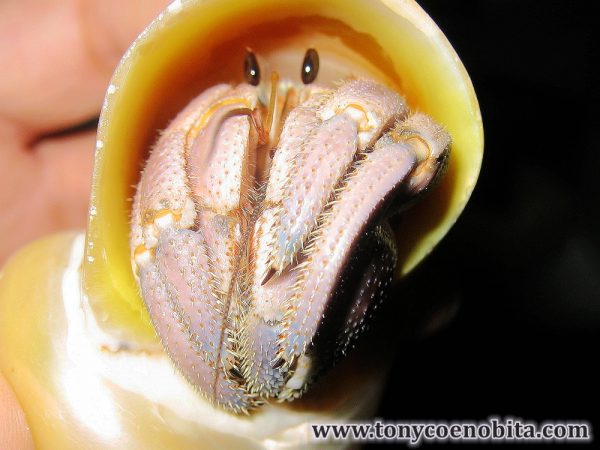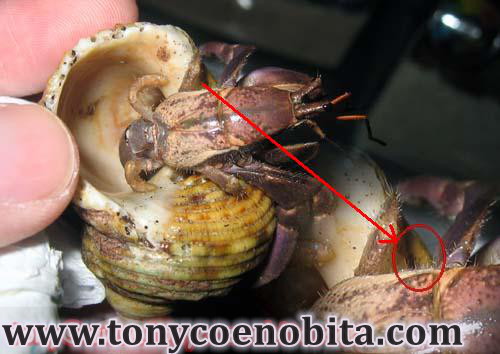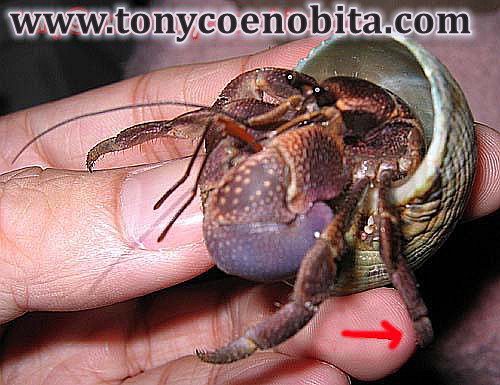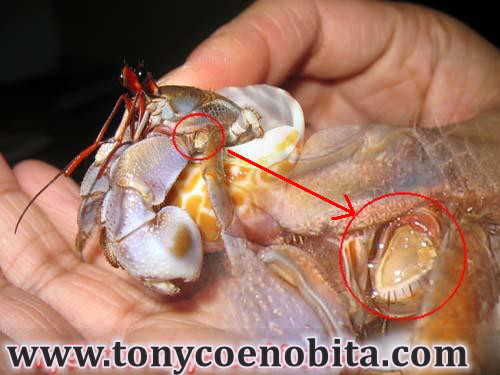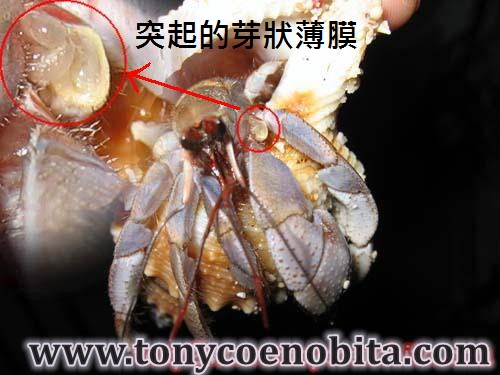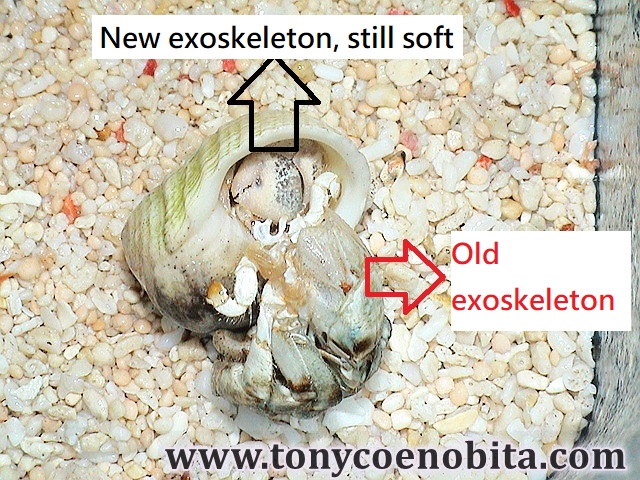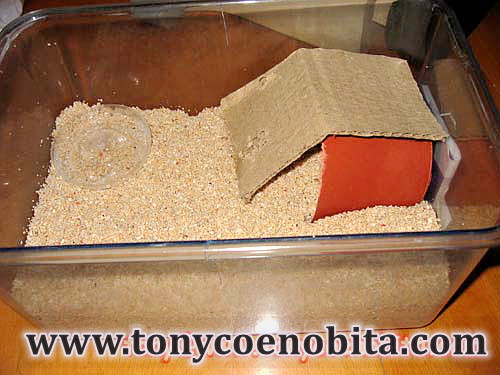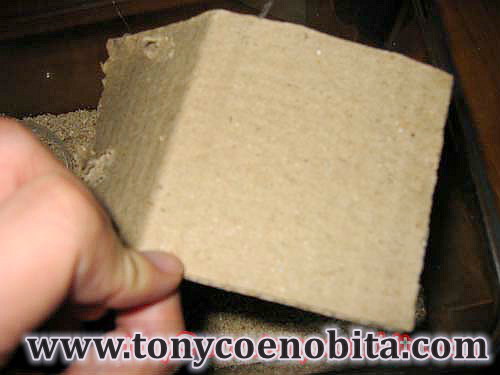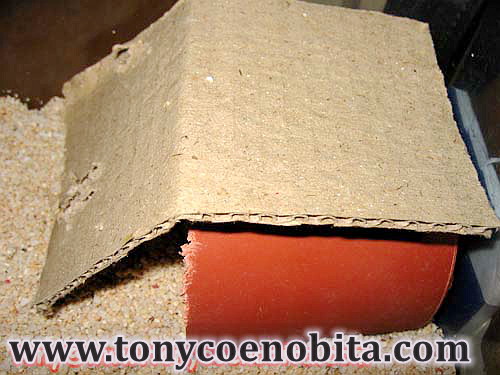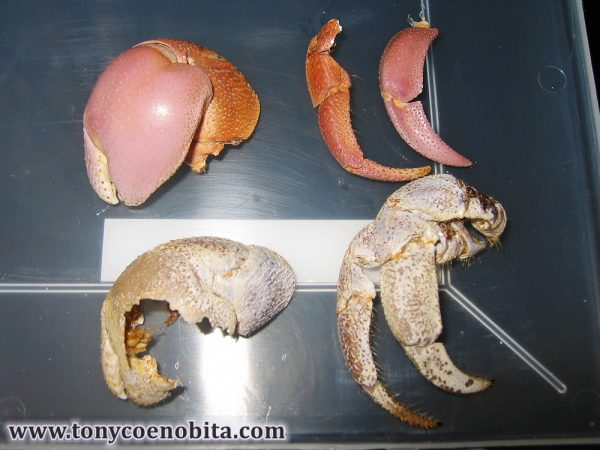Molting is a process when land hermit crabs grow. They will shed their old exoskeleton regularly and later the new exoskeleton hardens. This process is very important for them, if the crabs go through an unsuccessful molt, they may die.
*Normally, the crabs DO NOT left his shell (Naked hermit crabs) during molting.
Old exoskeleton – It is hollow and crumbles easily
New exoskeleton – It is soft before hardens
Molting Process
Generally, the whole molting process has 4 stages:
① Pre-molt
The crabs will find a suitable place to burrow underground. Old exoskeleton starts the separation process and new exoskeleton begins to build.
② Molt
The crabs start to shed an existing exoskeleton. The old exoskeleton cracks and the crabs pull out of it backwards. New exoskeleton of the crabs is soft just after molt, the old exoskeleton is positioned just in front of the mouth of the shell.
Old exoskeleton (Red circle)
③ Post-molt
The crabs use water in their shell to create water pressure to stretch the new exoskeleton into a larger size. Color of new exoskeleton is pinkish or pale. The crabs are unable to move completely until muscle regains control and hardens.
④ Recover
The crabs begin to eat the old exoskeleton which helps to recycle calcium, so that the new exoskeleton can fully harden.
To fully harden the new exoskeleton, generally small crabs take 7 days, medium crabs take 15 days, big or jumbo size crabs take 30 days. After that, the crabs still need some time to take a rest in the burrow, then they will back to surface.
Signs of Molting
Please pay attention to your crabs if they have below signs:
- Digging → Suddenly starts digging the substrate more than usual or repeatedly digging, that mean they are finding a suitable place prepare for molting, they will dig on coconut soil (fiber) area or substrate (sand) near water dish
- Burrowed underground deeply → Not back to surface in the next day
Digging on coconut soil (fiber) area
Digging substrate (sand) near water dish
- Drinking water → Spending more time in both the fresh water and salt water dishes, store an abundance of water to prepare molting
- Not eating too much → Some crabs are not eating too much or stop eating near molting
- Lethargy → Less active, stay near water dishes or stay in shelter
- Changing into a larger shell → Move into a larger shell before molting, may be larger shell can provide the crabs more room to hide, not disturbed easily or feel more comfortable. It is said that they may grow bigger after molting if they have a larger shell.
- Cannot fully hide into shell → The crabs suddenly expose more than usual, as molt sacs (For storing food and water reserves) occupy some space in their shell, so they cannot fully hide info shell before molting. They will back to normal after molting. IG reference link
More molting signs shared by Taiwan keeper C聖 (in Chinese)
Molt sacs (Red circle) on abdomen for storing food and water reserves
Isolation Molting Method (IMM)
It is said that almost 90% of deaths are related to molting. The proper environment is very important for a successful molting. Land hermit crabs need high humidity, dark and stable (undisturbed) environment for molting, burrow underground (molt camp) is the most suitable environment for them.
Unsuccessful molting always caused by disturbance. To make sure the molting crabs will be safe, we suggest to isolate the crabs for molting because even you have very large main tank and very deep substrate, there is still a chance that other crabs in the same tank may attack the molting one. The molting crabs may die due to stress (out of shell) or may be eaten by others.
Isolation Molting Method (IMM) is to make sure molting crabs stay alone and will not be bothered by other crabs. When we found a crab suddenly starts digging more than usual, repeatedly digging etc., we isolate the crab to an isolation tank. This method is widely using in some Asia’s keepers for many years (Some examples are over 10 years).
Isolation molting method can also ▷prevent flooding, mold or bug problem
**Captive bred crabs is an exception case as they are too small that is very different to isolate**
The setting of main tank for this method is different with setting using deep substrate.
At the beginning I took care of land hermit crabs, I used deep substrate for the whole tank. We know that the purpose of using deep substrate is for the crabs to dig for molting. If we use Isolation Molting Method, no need to have deep substrate for the whole tank anymore.
We use dry sand 3-5cm deep for substrate plus one or two we called isolation tank (with coconut soil / fiber) that deep enough for them to dig. Once we found the crabs start digging, have signs of molting or already burrowed underground, we take them out (isolate that crabs) to another tank with deep coconut soil (fiber), they will burrow underground again for molting. Isolated crabs will be safe as they will not be disturbed by other crabs when molting.
Setting of main tank
It is easy to see if the crabs burrowed underground or not in main tank. At the beginning surface of coconut soil (fiber) is flat (picture on left). You will see the surface of coconut soil (fiber) uplifted, that mean the crabs burrow underground (picture on right).
Moreover, if we check the condition of each crab every day, we can know which crab disappeared, that mean that crabs already burrowed underground.
TWO Options for how to isolate a crab burrowed underground, not back to surface in the next day:
① Directly put out the crab to another isolation tank, the crab will find a suitable place again and burrow underground again.
② Movable option is that if we found the crab already burrowed underground around 3-5 days in isolation tank (with coconut soil / fiber), we can take away that isolation tank (including the crab burrowed underground) out of the main tank. Then we replace another isolation tank (with coconut soil / fiber) in main tank for the next crab.
Above 2 Options depend on how many crabs have or which one is more suitable for keepers.
Although some crabs started digging, but they are not yet ready to molt.
① Start digging, but not burrow underground, this sign may up to one month or longer.
② Start digging, sometimes burrow underground normally only one night and back to surface the next day, this sign may up to more than one month.
From my experience, if we isolated this kind of crabs, they will stop digging and will not burrow underground, 2-3 days later then we have to move them back to main tank.
Please be patient, we have to wait them burrowed underground deeply in main tank (2-3 days) and we can isolate them, then they will burrow underground in isolation tank soon.
P.S. if we have molting cycle record and those crabs have molting signs at the same time, especially the big or jumbo crabs usually molt once per year, that mean they soon to start molting. However, molting cycle will be different when they grow gradually.
Isolation tank:
We can use plastic tank for isolation tank, there are many different sizes in the market.
Different sizes of plastic tank
Substrate for isolation tank:
Land hermit crabs need high humidity environment for molting.
Until 2009, we used moist sand for molting substrate (idea from Japan, my basic care for land hermit crabs is from Japanese websites), but there are some disadvantages.
① The crabs need moisture to form a burrow for molting. Burrow made of moist sand will easily collapse if drying out, the crabs may not able to harden their new exoskeleton during molting or the worst case is the crabs will be buried and die.
② Most important point is moist sand only suitable for small or medium size crabs to form a burrow. Big or jumbo size crabs are unable to form a large burrow in moist sand. Finally they will back to surface and molt in shelter or surface molt.
In 2009, a Taiwan keeper shared his experience in my forum, mentioned that he used coconut soil (fiber) for molting substrate for his jumbo size crab and molted successfully.
Coconut soil (fiber) used for reptile all the time, but we did not notice that it can be used for land hermit crabs.
2 topics about this in forum (in Chinese):
In 2012, another Taiwan keeper C聖 shared the setting of his main tank and isolation tank in my forum and said that coconut soil (fiber) was very good for molting.
4 topics about this in forum (in Chinese):
Why coconut soil (fiber) is good for moting?
① Helps maintain humidity for a long time, can form a better burrow, not easy to collapse. This can provide a suitable room for molting.
② Suitable for all sizes of crabs, can prevent surface molt of big or jumbo size crabs. Especially big or jumbo size crabs, they need more space for molting. If they cannot dig a suitable space or disturbed by others, they will surface molt.
③ If we can prevent surface molt, it can help the health of the crabs for long term. As we found that surface molt will affect the quality of new exoskeleton, see ▷Surface Molt
Burrow formed from coconut soil (fiber) can provide a suitable room for crabs for molting, example 1
Burrow formed from coconut soil (fiber) can provide a suitable room for crabs for molting, example 2
How to use coconut soil (fiber):
Coconut soil (fiber) (compressed brick) can be found in pet shop (for Reptile Bedding).
Place the compressed brick in a plastic tub or container. It will begin to expand once water is added, it will absorb all the moisture and break down. Use your hands to break up to allow moisture to penetrate.
Continue to add water until the brick is fully broken up. It feels moist and soil-like. The best condition is to be damp but not too wet.
Different bands of coconut soil (fiber):
✔️ Komodo Tropical Terrain Compact Brick
✔️ Reptizoo Coconut Fiber Substrate
✔️ Reptile Daddy Cocopeat
✔️ Exo Terra Plantation Soil
✔️ Zoo Med Eco Earth Coconut Fiber Substrate
What we used here is NOT coconut CHIPS.
❌ Reptizoo Compressed Coco Chips
❌ Reptile Daddy Coco Chips
❌ Exo Terra Coco Husk
coconut soil (fiber) suitable for molting
EZ soil in Taiwan, suitable for molting
Use chopsticks to drill a hole on coconut soid (fiber), see below movie:
Size and setting of isolation tank:
Size of isolation tank should be at least 2-3 times of the size of the crabs. Please make sure substrate is at least 2 times the height of the crabs. (Normally 10-15cm or above).
Pay attention that isolation tank should have enough space to put below items inside.
- A shelter (OPTIONAL) If you think the crab will burrow underground soon, no need to put
- A fresh water dish and salt water dish (For example, small plastic dish for small size crabs, reptile water dish for medium, big or jumbo size crabs)
- A food dish (OPTIONAL) If you think the crab will burrow underground soon, no need to put
Plastic dishes for water dish in isolation tank for small size crabs
Where I place the isolation tanks
How to maintain the condition of coconut soil (fiber):
Moist coconut soil (fiber) can maintain humidity for one to two months or above.
① If the crabs already burrowed underground in isolation tank → When you see the surface of coconut soil (fiber) became dry, color turned lighter from down brown to light brown, only spray the surface of coconut soil (fiber) to increase moisture, this will not affect the molting crabs.
② If NO crabs burrowed underground in isolation tank → Unless you found coconut soil (fiber) with mite problem, otherwise just let it be, seal it with plastic wrap. Please adjust moisture again when you use it in next time.
③ Isolation tank in main tank → If you see that the surface of coconut soil (fiber) became dry, color turned lighter from down brown to light brown, dig it and adjust moisture again, so that the crabs can dig and burrow underground.
Molting Cycle
Molting cycle mean molt time per year of land hermit crabs.
Generally, it depends on different environment, temperature and each crab will be different.
Below table show roughly how many times the crabs molt per year, time for molt including length of time burrowed.
About the size of the crabs, I roughly see the area in blue circle
Molting Season
In Asia, it was said that molting peak season of land hermit crabs is autumn and winter. My record from 2006-2014 was during spring and summer. However, molting season may change based on different climate in different area or different individual crab.
Matters Needing Attention
① Molting record
Please properly check the condition of your land hermit crabs every day and keep record (Which month? How many days?) for every molt. Then you will have a clear picture of the molting cycle of each crab and know which crab will be ready to molt in next time. The record is very useful for isolation.
② Patience
Please keep patience to wait the crabs back to surface. Please DO NOT disturb or dig the substrate to see if the crabs are still alive.
Please be noted that even medium size crabs may burrow underground over 60 days in winter, big or jumbo size crabs over 100 days (or over 120 days).
③ Character
Character of individual crab is different, some crabs start digging everywhere, but will not burrow underground in a short time.
Some crabs will burrow underground at night in winter for keep warm, not for molting, they will back to surface on the next day.
One more time, if you know more about and have record for each crab, it will be more easily to know properly when they will molt.
Change in Appearance after Molting
Land hermit crabs will back to surface after molting. If you found they have needle-sharp nails, body hair became hairy, then you can put them back to main tank.
Moreover, you may see that their body color changed. Color change may relate to daily diet.
Of course, different species have different coloration when they grew up.
*In Asia, we have experience that Coenobita perlatus will lost color after molt, please refer to Coeonbota perlatus (C.perlatus) suitable in Crabitat? 。
Needle-sharp nails
Body hair became hairy
Missing Limbs Begin to Regenerate
Land hermit crabs can regenerate missing limbs (leg or claw) after molting.
If only small part of leg or claw (dactylus or propodus) missed, it can be fully regenerated in next molt.
If a whole leg or claw missed, firstly limb bud will be formed in next molt. Eventually the whole leg or claw will grow to normal size after 2-3 molts.
Example ①
Whole leg regenerated after molting for 51 days. Red circle is limb bud.
Example ②
Whole leg regenerated after molting for 33 days. Red circle is limb bud.
Surface Molt
Surface molt is when land hermit crabs cannot find a suitable place for molting, they molted on substrate instead of in the burrow. With their old exoskeleton along the shell on the substrate.
That mean there is something wrong with your main tank setting. Surface molt is NOT proper molt.
If you found surface molt crabs, please isolate them and double check the environment of your main tank.
How to handle with surface molt:
Please gently pick up the crab with its old exoskeleton and isolate to a temporary tank with substrate. It is better to put the crab together with its old exoskeleton to a shelter, use something (e.g., moisture paperboard) to seal the opening of the shelter in order keep high humidity.
Use a tower to cover the tank to create a fully dark environment.
Please wait until the crab walk out from the shelter, then you can move it to the main tank.
Sequelae of Surface Molt:
① The crabs feel stress as surface molt (without any shelter) cannot provide a dark environment. It is also very dangerous as surface molted crabs may be bothered by other crabs, lose limbs or even eaten by other crabs and die。
② We found that surface molt will affects the quality of new exoskeleton. For long term, it also affects the health of the crabs.
1. Molted crabs almost will not eat all the old exoskeleton under this stress circumstances.
2. New exoskeleton became dry, thin (weak), not so shinny as original. This may be a kind of shell disease. It will affect the next molt or the crabs may die during the next molt.
3. If the crabs molted under the environment with not enough moisture or not molted underground, their size do not grow a lot after molted, or size will even become smaller.
Upper: Normal old exoskeleton
Bottom: Old exoskeleton from surface molt, very dry and thin (weak)
Unsuccessful Molting
Unsuccessful molting always caused by disturbance. We DO believe that even you have very large main tank and very deep substrate, we CANNOT prevent that there is a chance molting crabs will be disturbed by other crabs. Space is limited in a sealed tank especially some people have so many crabs in one tank. We want all the crabs molting alone in a safe way. More land hermit crabs you have, the greater the responsibility. Please be careful of overcrowding.
On the other hand, some strong crabs will molt even though the environment is not suitable for molting.
I had an experience long time ago, I bought a land hermit crab from pet shop. The seller told me that I can use little water for setting, no need any substrate.
I used a plastic board for land with little water. Only gave the crab apple for food as suggested by the seller.
Few months later, I found he molted, I took his old exoskeleton out for collection as I did not know he will eat the old exoskeleton. Few days later, he was dead.
That mean the most important thing is if the crabs can survive or not after molting.
If we can save the crabs from surface molt, they may able to survive.
If not, they may be eaten by other crabs, out of shell or die due to stress. This cases also belong to unsuccessful molting.
Prevent flooding, mold or bug problem
Why I always see overseas keepers said their tank has flooding, mold or bug problem?
Overseas crabitat is let the crabs molting in main tank with deep substrate, no isolation, so keepers will not usually clean the substrate (only if they face flood or bug problem etc), some keepers may be even do not clean it for many years.
① Tank is sealed, the crabs always bring water out from pool or water dishes, water accumulate over a long period of time, so flood eventually caused.
② The crabs sometimes bring food out of food dish and bring it to their shelter, food detritus will mix with substrate (especially some food in flake or powder), but as keepers do not do deep clean for substrate, this will cause moldy or bug will visit.
In Asia, we isolate the crabs out of main tank for molting, no need to use deep substrate for main area. So, we can DO DEEP CLEAN clean substrate regularly without disturb the molting crabs, we can keep the substrate in better condition.
*Most important is I saw overseas keepers do deep clean when face emergency problem, they have to move all burrowed underground crabs to the surface and it definitely affect those molting crabs.
